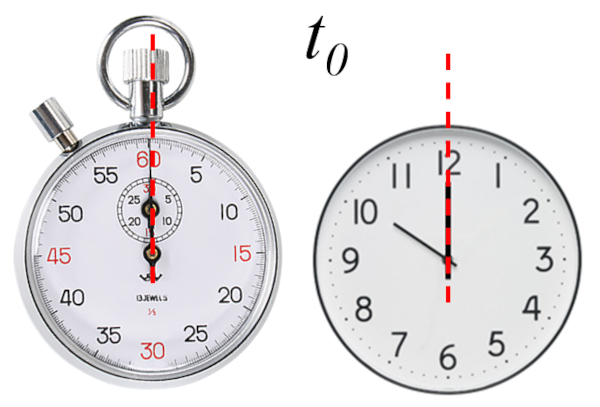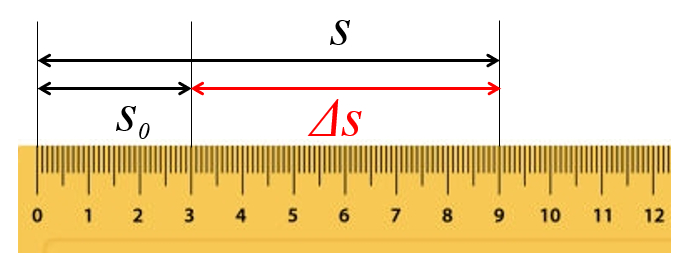Mechanisms
Iframe 
The key to describing motion at a constant velocity is understanding the concept of:
• Position,
• Displacement,
• Time, and
• Elapsed time
to define velocity. Finally, graphical representation and interpretation are discussed.
Mechanisms
ID:(15999, 0)
Position
Concept 
The position ($s$) of an object in a one-dimensional system refers to the location of the object in relation to a reference point. This location is expressed as the distance between the object and the origin point. This distance can be a straight line on a Cartesian axis, or it can follow a curved path:

Position along a road following its axis
ID:(15, 0)
Initial position
Concept 
The starting position ($s_0$) is the starting location of an object before any motion begins. This location is defined as the distance between the object and the origin point. This distance can be a straight line on a Cartesian axis or it can follow a curved path.

Initial position along a road following its axis
ID:(10302, 0)
Distance traveled
Concept 
The distance traveled in a time ($\Delta s$) for an object is determined by measuring the distance between two specific points along a path. This path can be a straight line on a Cartesian axis or a curved trajectory. The distance is calculated as the length of the path connecting the initial and final points.

Distance traveled from an initial point to a final point
Since the value of the distance traveled in a time ($\Delta s$) is calculated as the difference between the position ($s$) and the starting position ($s_0$):
| $ \Delta s \equiv s - s_0 $ |
it is possible to "shift" the origin of the position by adding a constant value $d$ to both quantities:
$s \rightarrow s + d$
$s_0 \rightarrow s_0 + d$
without affecting the result of the distance traveled:
$\Delta s = s - s_0 \rightarrow (s + d) - (s_0 + d) = s - s_0 = \Delta s$
This concept is known as spatial invariance, which implies that the value of the distance traveled does not depend on the specific point where the measurement begins.
This means that the laws formulated using this principle will be spatially invariant, i.e., they will remain valid regardless of the location where the measurement is made.
ID:(9495, 0)
Time
Concept 
The evolution of any system is described by different parameters, each one evolving according to a scale called the time ($t$).

Time indicated by a clock, either the value at which it is marked or the hour
Traditionally, time was considered absolute in classical physics, being the same in all reference systems. However, the theory of relativity has generalized this concept and now it must be seen as unique to each reference system, being able to differ in its advancement.
ID:(478, 0)
Initial time
Concept 
Systems are time-invariant, meaning that their behavior is not affected by when the process begins. This allows us to choose the start Time ($t_0$), based on what is most convenient. This could be based on the instrument used to measure the time or to make calculations easier.

The time at which the measurement starts, whether fixed or by system (stopwatch)
Ultimately, the beginning time can be chosen freely.
ID:(715, 0)
Time elapsed
Concept 
The foundation of describing any evolution is the definition of time in which it is described. Specifically, we work with the time elapsed ($\Delta t$) from a reference time.

The stopwatch directly gives us the elapsed time since its initial time is zero
In the case of a stopwatch, the elapsed time is measured from the start of its measurement, i.e., a zero initial time ($t_0=0$).

In the case of the clock, it is necessary to define the initial type in order to determine the elapsed time.
In the case of a clock, the elapsed time is measured from a defined initial time, which may or may not be zero.
Since the time elapsed ($\Delta t$) is calculated as the difference between the time ($t$) and the start Time ($t_0$):
| $ \Delta t \equiv t - t_0 $ |
it is possible to "shift" the time origin by adding a constant value
to both time points:
$t \rightarrow t + \tau$
$t_0 \rightarrow t_0 + \tau$
without affecting the elapsed time:
$\Delta t = t - t_0 \rightarrow (t + \tau) - (t_0 + \tau) = t - t_0 = \Delta t$
This property is known as temporal invariance, meaning that the elapsed time remains unchanged regardless of the specific starting point of the measurement.
Consequently, laws formulated using this principle will be temporally invariant, meaning they remain valid whether applied in the present, the past, or the future.
ID:(12507, 0)
Constant speed
Concept 
The constant velocity ($v_0$) can be calculated from the distance traveled in a time ($\Delta s$) and the time elapsed ($\Delta t$) as follows:
the distance traveled in a time ($\Delta s$) is measured or calculated from the positions:

The path traveled is determined from the initial and final positions
Meanwhile, the time elapsed ($\Delta t$) is measured or calculated from the time:

The elapsed time is determined from the initial and final times
This allows us to define the constant velocity ($v_0$):
| $ v_0 \equiv\displaystyle\frac{ \Delta s }{ \Delta t }$ |
which represents how distance is covered over time:

The velocity is obtained from the path traveled and the time elapsed
In the example, the path traveled is $\Delta s =9 cm - 3 cm = 6 cm$, and the elapsed time is $\Delta t = 10:10-10:00 = 10 min$. Thus, the velocity is:
$v_0 = \displaystyle\frac{6\text{cm}}{10\text{min}} = 0.6\text{cm/min}$
It is important to note that since $\Delta s$ is spatially invariant and $\Delta t$ is temporally invariant, the definition of velocity is both spatially and temporally invariant, meaning it holds true in all locations and at all times.
Additionally, if the principle of inertia is applied, which states that in the absence of external forces, the velocity remains constant, this invariance ensures consistency across all scenarios.
ID:(16001, 0)
Model
Top 
The base model relates the position ($s$), measured from an origin the starting position ($s_0$), resulting in ($$), and the time ($t$), measured from an origin the start Time ($t_0$), resulting in the time elapsed ($\Delta t$). From these differences, the constant velocity ($v_0$) is defined
The base relationship of the model is the straight line that associates the central variables of the model:

With this, the network structure of the model is:
Parameters
Variables
Calculations
Calculations
Calculations
Equations
$ \Delta s \equiv s - s_0 $
Ds = s - s_0
$ \Delta t \equiv t - t_0 $
Dt = t - t_0
$ s = s_0 + v_0 ( t - t_0 )$
s = s_0 + v_0 *( t - t_0 )
$ v_0 \equiv\displaystyle\frac{ \Delta s }{ \Delta t }$
v_0 = Ds / Dt
ID:(15998, 0)
Distance traveled
Equation 
We can calculate the distance traveled in a time ($\Delta s$) from the starting position ($s_0$) and the position ($s$) using the following equation:
ID:(4352, 0)
Elapsed time
Equation 
To describe the motion of an object, we need to calculate the time elapsed ($\Delta t$). This magnitude is obtained by measuring the start Time ($t_0$) and the the time ($t$) of said motion. The duration is determined by subtracting the initial time from the final time:
ID:(4353, 0)
Constant speed
Equation 
The constant velocity ($v_0$) can be calculated from the distance traveled in a time ($\Delta s$) and the time elapsed ($\Delta t$) using:
ID:(16000, 0)
Case of Constant Speed
Equation 
If the speed is constant, the velocity will be equal to the initial Speed ($v_0$). In this case, the distance traveled as a function of time can be calculated using the difference between the position ($s$) and the starting position ($s_0$), divided by the difference between the time ($t$) and the start Time ($t_0$):
With the distance traveled in a time ($\Delta s$) it is with the position ($s$) and the starting position ($s_0$):
| $ \Delta s \equiv s - s_0 $ |
and the time elapsed ($\Delta t$) is with the time ($t$) and the start Time ($t_0$):
| $ \Delta t \equiv t - t_0 $ |
The equation for average velocity:
| $ v_0 \equiv\displaystyle\frac{ \Delta s }{ \Delta t }$ |
can be written as:
$v_0 = \bar{v} = \displaystyle\frac{\Delta s}{\Delta t} = \displaystyle\frac{s - s_0}{t - t_0}$
thus, solving for it we get:
| $ s = s_0 + v_0 ( t - t_0 )$ |
The corresponding equation defines a straight line in space-time.
ID:(3154, 0)
